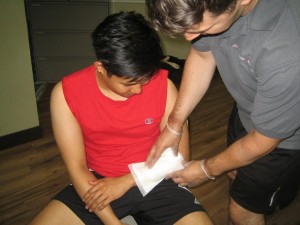Every year, millions of individuals are bitten by animals. Most cases of animal bites occur on the fingers of the dominant hand, but animal bites can also occur in the neck area and head. Those who have pets must observe measures to avoid bites. Bites can also come from wild animals, thus you have to be prepared with what to do in case you or someone incurred a bite. All you have to do is to register for first aid training today.
Common causes
Most cases of animal bites are from dogs. The bites from cats are the second most common cause of animal bites. It is important to note that the risk for infection from a bite of a cat is considered higher than a dog.
A big issue for concern when it comes to animal bites is the risk for rabies. Since most pets in developed countries are vaccinated, most cases of rabies are due to bites from wild animals such as raccoons, skunks or bats.

In other countries that have not yet implemented strict vaccination protocols on animals, the usual source of rabies are dogs. Many individuals incurred bites not just from pets but also from stray dogs as well as wild animals. If an individual with rabies is not promptly treated, it can lead to death.
Symptoms
An individual who sustained an animal bite is at risk for infection. It is important to watch out for the following signs and symptoms that an infection has developed in the bite site.
- Pain
- Swelling
- Warmth around the bite site
- Redness surrounding the bite site
- Drainage of pus
In case an animal bite did not break or open the skin, it can cause tearing or crushing injury to the underlying muscles, tendons, ligaments, bone and nerves. Damage to the nerves and tendons are characterized by loss of sensation on the fingertips as well as inability to bend or straighten the finger on the affected arm.
How animal bites are diagnosed
The individual should be taken to the hospital or doctor as soon as possible. The doctor will cleanse the bite site thoroughly and assess for any indications of tendon or nerve damage. The arm or leg that was bitten is examined for any signs that the infection has already spread.
Treatment of animal bites
Do not attempt to suck out the blood from the bite site. Remember that the mouth contains bacteria that will only lead to the development of infection.
When it comes to superficial wounds, the area must be cleansed thoroughly using water and soap. An antiseptic can also be used such as alcohol or hydrogen peroxide. After cleaning, you have to dab on an antibiotic ointment over the bite site and cover it with a non-adhesive bandage. The bite site must be monitored for signs of damaged tendons or nerves. In some cases, bruising can also develop. The bite site must heal within a span of 10 days. In case the wound does not heal properly, there are signs of infection or indication of damage to the tendons and nerves, it is best to seek medical care.
